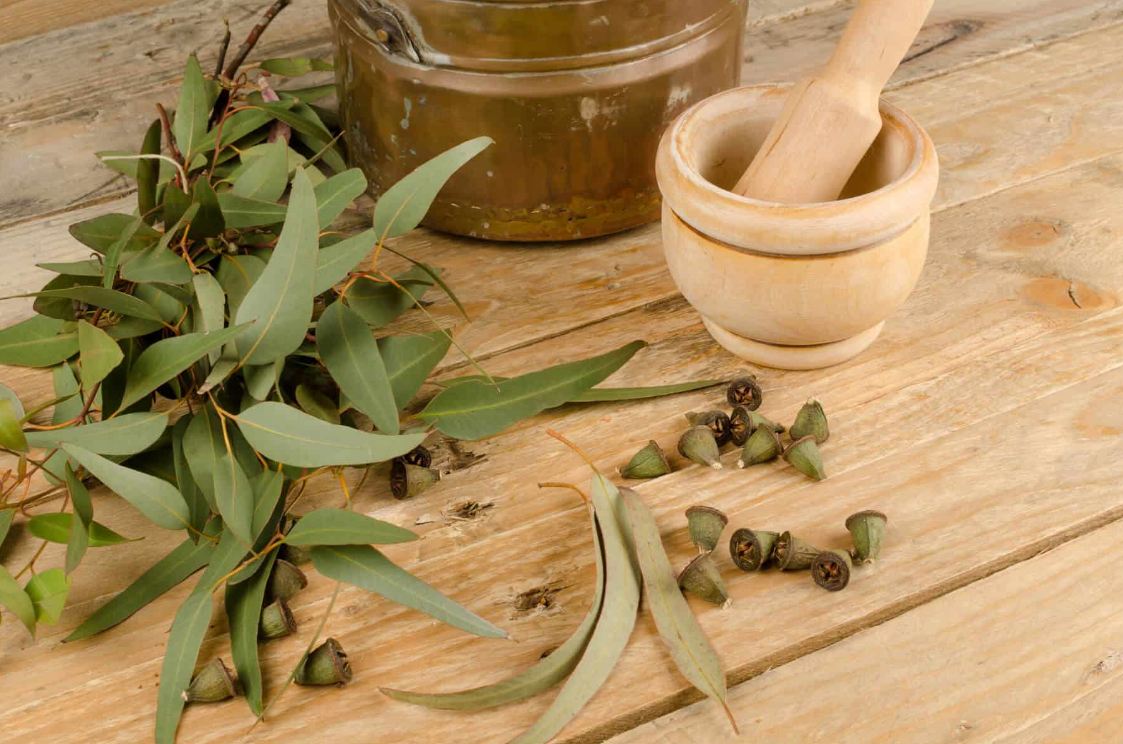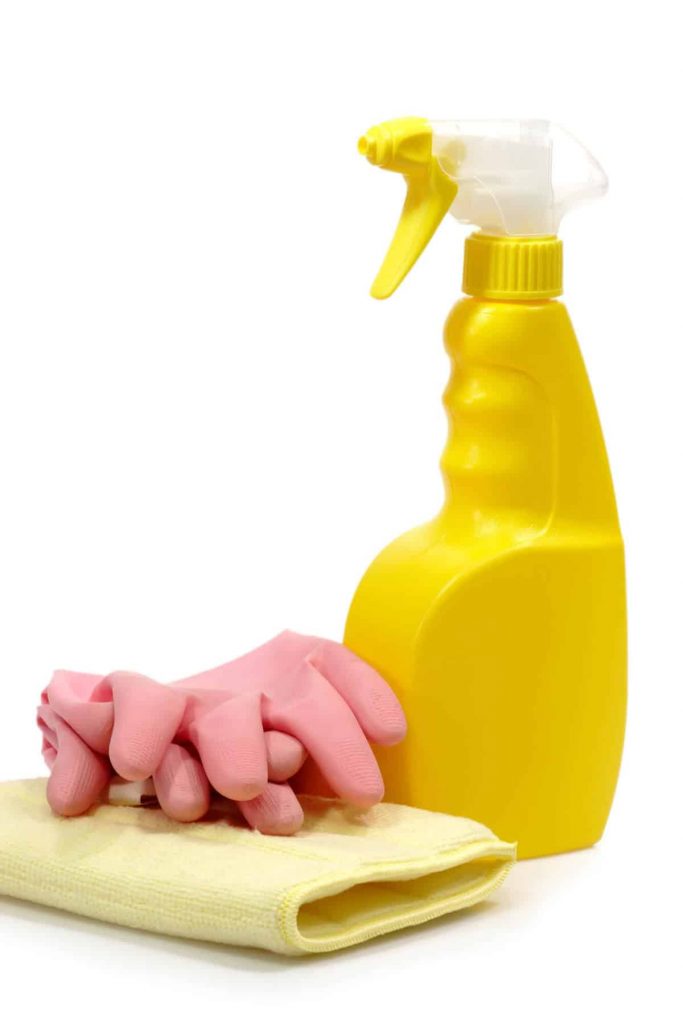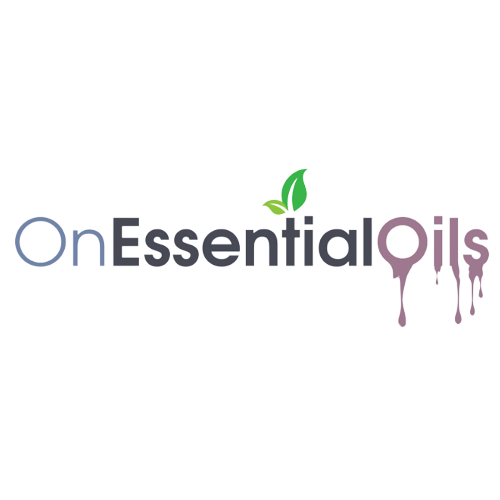From the myrtle family (Myrtaceae), Eucalyptus L’Héritier 1789 is a diverse genus of flowering trees and shrubs. Members of this genus are dominant in Australia and include Eucalyptus regnans, which is the tallest known flowering plant on Earth. The indigenous people of Australia have used eucalyptus oil for centuries to relieve everything from common aches and pains to cold and flu symptoms.
There are more than 700 species of eucalyptus growing in the world, with the vast majority grown in Australia. The first production of eucalyptus essential oil began in 1852 in Victoria, Australia. By the turn of the 20th century, it was well established and eucalyptus oil was being exported to many countries. Over the next 50 years, this distinctively Australian industry was the major supplier of eucalyptus oil all over the world.
The oil is extracted by steam distillation, which separates the essential oil from the dried eucalyptus leaves. That extracted oil is used in countless health-related treatments and products.
Quick Links: For your convenience, here are store links to items we mentioned in this article.
Product Name | ||
Frankincense, Sacred Essential Oil | Helps improve the appearance of all skin types while toning and tightening the skin | |
Chamomile, Roman Essential Oil | The oil has a warm, sweet, herbaceous, and fruity fragrance, presenting middle-top notes. | |
Basil Essential Oil | The essential oil is soothing when applied topically or diffused. | |
Medical grade inhaler | Made from higher density medical graded plastic and seal tight to prevent your expensive essential oils from evaporating or oxidizing. | |
Tamanu Oil | Has anti-inflammatory, antioxidant, antimicrobial, and antibiotic properties. | |
Sweet Almond | A gentle (yet powerful), carrier oil that is excellent for all skin types | |
Jojoba Oil | Jojoba oil is not greasy, making it a wonderful choice for skincare products. | |
Coconut Oil | The oil is not mass produced, but made by hand just as it has been done for hundreds of years. |
In terms of application today, eucalyptus oil is used in insect repellent (Lemon eucalyptus), as a disinfectant, for asthma treatment, and other uses too numerous to mention here.
Many use a eucalyptus oil base as a shaving soap and aftershave balm, as it both prevents and soothes the irritation of razor burn. But that’s merely the tip of the iceberg for this multi-purpose oil.
Before we begin, however, let’s learn a little more about these amazing plants.
See the following chart to view the various species of eucalyptus and their therapeutic actions and percentages of active components within each one.
9 Nutty Facts About Eucalyptus Trees
- Eucalyptus trees belong to the myrtle (rhymes with turtle) family
- They are indigenous to Australia but have spread to other countries
- There are more than 700 species of eucalyptus in the world
- They are the second tallest trees in the world, only the coast redwood (Sequoia sempervirens) reaches greater heights
- The word Eucalyptus is derived from the Greek Eucalyptos, meaning, well-covered
- Some species can grow a mind-splintering 125 feet in just 3 years
- The Eucalyptus camaldulensis (a gum species) can live 500 to 1000 years
- The koala bear rarely drinks water-his water comes from the koala’s food, eucalyptus leaves
- The tallest eucalyptus specimen – nicknamed ‘Centurion’ – stands at 99.6m (that’s over 326 feet!) in Tasmania’s Arve Valley. It’s the tallest flowering tree recorded on earth.
Cool stuff, huh?
Below are 15 ways the various species of eucalyptus essential oil can be instituted into your health routines. There is no doubt this amazing oil helps make people’s lives better every day.
1. A Natural Cough Suppressant
For over a century, people in the western hemisphere have been using eucalyptus oil to treat coughs and upper respiratory irritation. Most cough drops on the market today contain a small concentration of eucalyptus oil to scratch that tickling itch in your throat. The vapors produced by eucalyptus oil work to soothe irritated nerves in your respiratory tract as well as acting as a numbing agent.

As a testament to the power of eucalyptus oil as a cough suppressant, Vick’s VapoRub, an over-the-counter topical mentholated ointment, uses a 1.2% concentration of eucalyptus oil.
*Due to some of the constituents within eucalyptus species, it is not recommended for internal use. Piperitone is an example of a constituent, that, when ingested can induce vomiting and diarrhea. (1)
The following recipes will soothe your throat and ease your cough along with having the wonderful properties as an anti-viral and anti-bacterial. Since we avoid using eucalyptus internally, we’ve included an inhaler with Eucalyptus citriodora.
Cough Syrup
- 4 ounces honey (heat on stove to boiling, simmer 15 minutes, turn off)
- 2 drops Peppermint Mentha x piperita (Buy it here)
- 2 drops Ginger Zingiber officinalis (Buy it here)
- 6 drops Lemon Citrus limon (Buy it here)
After turning off honey, add essential oils, pour in a glass bottle, and seal immediately. Will keep 2- 3 months.
*Note: For children under 5, replace Peppermint with Spearmint Mentha spicata (Buy it here).
*Because of infant botulism, it’s advised against giving honey to children 1 and under. I did not give it to my children until 2 years of age. Children that are 2 years and older develop helpful bacteria in their intestines, which act as a defense against the harmful spores that can cause infant botulism.
Inhaler:
- 1 blank inhaler
- 5 drops Eucalyptus Eucalyptus citriodora (lemon)
- 5 drops Rosemary Rosmarinus ct. verbenone
- 5 drops Frankincense Boswellia carterii
Add, inhale as needed.
Important Note: Whatever you choose for an oil, make sure the ones you purchase are high quality. Check the GC/MS (gas chromatography/mass spectrometry) analysis reports prior to purchase. A reputable company that offers pure unadulterated oils will have these reports readily available to their clients on site. All the companies I use have the GC/MS reports on site. Remember, you’re breathing this oil into your lungs so essential oil quality is of the utmost importance.
2. Cold and Flu Relief
One of the greatest benefits of eucalyptus oil is its function as an expectorant. Whether you are still suffering from the cold or flu or remnants of it, an expectorant will help to clear out the left behind mucous build up. An expectorant works to release sputum, phlegm, and mucous from our airways.
Dr. Jean Valnet speaks of how one must take a strong antibiotic “from three to upwards of twenty days – and this would be for a feverish condition, straightforward bronchitis or simply nasal catarrh. The essences of eucalyptus would have dealt with such conditions in a matter of 24-48 hours – 8 days at the most for the stubborn cases.” (2)
For daytime or night relief, the following will open your airways to make sleeping more comfortable. The sweet marjoram, frankincense, and vetiver will help you rest more peacefully since these oils also are calming and sedative to the CNS (central nervous system). Vetiver is also known for its support during grief or sadness because it really puts you in a peaceful state of mind.
Cold and Flu Symptom Relief Chest Rub
- 1-ounce unscented cream or carrier oil
- 3 drops Sweet Marjoram Origanum majorana
- 3 drops Frankincense Boswellia carterii
- 3 drops Eucalyptus Eucalyptus citriadora
- 9 drops Vetiver Chrysopogon zizanioides or Ruh Khus Vetiveria zizanioides
Leave out the cream and use this blend to diffuse.
*Note: To avoid possible neurological side effects, Robert Tisserand suggests diffusing at no more than 30-minute intervals, with at least 10-minute breaks. For children 5 and under, direct diffusion is the biggest concern. Direct diffusion includes inhaling oils from hands, on a cotton ball, in a steam, or through the use of inhalers. (3)
Alternatively, you can use eucalyptus using a simple steam technique. Steam is a great way to open clogged passages and the respiratory system. Avoid oils that are hot or spicy, such as nutmeg or black pepper. You’ll need a few supplies to prepare. Use no more than 1-2 drops, either alone or in the following blend. There is no need to use more than suggested amount to achieve end results.

Heat a quart of water on the stove to boiling point but DO NOT BOIL. We just want it hot. Transfer to a ceramic bowl. Add chosen oil/oils, close your eyes, cover head with a small towel, and breathe in the steam.
You can do this up to 10 or more minutes, taking breaks in between. Once the water is cool, uncover and let it sit to cleanse the air. The following blend can also be used in a steam:
Note: If using citrus oils, they should be kept at no more than 10-15% of the total blend. This will help to avoid any mucous membrane irritation. So, for example, if we were making a blend of 30 total drops, then we would use no more than 3-4 drops of citrus oil. You can make a stock blend, one you can use more than once.
The following stock blend is exceptional:
- 18 drops Eucalyptus globulus or Eucalyptus radiata
- 10 drops Tea Tree Melaleuca alternifolia
- 2 Drops Lemon Citrus limon
Using 1-2 drops, you are now ready for your steam. Store your remaining stock blend in a cool dark place to preserve the shelf life of the blend.
3. Hair and Eucalyptus
Shampoos and soaps made with eucalyptus are wonderful for stress relief and soothing sore muscles in your neck and shoulders. One way you can use eucalyptus essential oil is to make your own hair and skin lotion. However, most are irritants so choosing a skin-friendly eucalyptus is imperative to avoid irritation. Another thing to consider is the maximum percentage that can be topically used safely, yet effectively. At 2% and above, eucalyptus was irritating to various subjects (4). For this reason, we’ve stayed at a safe 1% or less.
Whenever using oils that have possible irritation to skin, use them along with skin-friendly oils to help ease the possibility of irritation. I’ve chosen helichrysum for its cicatrisant (skin healing) properties and patchouli for its wound healing properties and ability to ease scalp irritations. They compliment eucalyptus nicely in skin blends.
Soothing Eucalyptus Shampoo
- 4 Ounces unscented shampoo
- 3 drops Eucalyptus Eucalyptus citriodora
- 10 drops Patchouli Pogostemon cablin
- 5 drops Helichrysum Helichrysum italicum
4. Sinus and Allergies
For sinus and bronchial infections, we go with Eucalyptus odorata. When eight eucalyptus essential oils were tested in a study, Eucalyptus odorata stood out amongst the others. The cytotoxic effect and the antiviral activity varied significantly within eucalyptus species oils. E. odorata showed the strongest activity against several strains including S. aureus, H. influenzae, S. agalactiae, and against all the tested fungal strains. For further details, see reference. (5)

Use with other oils that have similar properties can help ease symptoms and discomfort from sinus inflammation and swelling.
Do the following:
- 1 Inhaler
- 6 drops Eucalyptus Eucalyptus globulus
- 3 drops Tea Tree Melaleuca alternifolia
- 2 drops Rosemary Rosmarinus officinalis ct. 1,8 cineole
- 3 drops Lavender Lavendula angustifolia
Note:Due to eucalyptus and rosemary and possible neurological effects, this inhaler is not for children under 10 years of age.
5. Household Use
Because of Eucalyptus globulus’ strong anti-bacterial actions and antimicrobial properties, it’s a good addition to your cleaning products. You can blend 1-2 drops into a tablespoon or so of pine oil, then add to your water to wipe down your counters and mop your floors. It’s refreshing and keeps us healthy.
*Caution though! If you have pets or small children, we discourage using essential oils in cleaning supplies since their respiratory and neurological systems are much weaker than ours.
6. Insect Repellent
Recently, the Center for Disease Control (CDC) released a report on the use of lemon eucalyptus oil in insect repellant products. (6)
I’ve personally experienced its success in a blend. We had a wedding of 300 hundred in August in Louisiana, the land of mosquitoes. On our country property next to the mosquito loving lake, with the following blend, we danced into the night and not a single guest had concerns of mosquito bites. It is child safe and effective.
Bug Out
- 2-ounce unscented lotion, cream or carrier oil
- 10 drops Patchouli
- 5 drops Vanilla Oleoresin
- 5 drops Cedarwood Juniperus virginiana
- 2 Drops Eucalyptus Eucalyptus citriodora (lemon)
Apply to exposed skin to head off mosquitoes. Application lasts 4-6 hours.
7. Disinfectant

The Aborigine tribes of Australia have historically used eucalyptus leaves and essential oils to bind wounds and treat burns. Eucalyptus oil acts as a natural disinfectant in cleaning a wound or burned area of the skin. Additionally, its anti-microbial nature helps prevent infections during recovery, and the anti-inflammatory properties ease pain and speed the healing process. How can you use it effectively?
Try the following:
- 2 ounces Forahana Tamanu Oil
- 5 drops Eucalyptus Eucalyptus globulus
- 10 drops Helichrysum Odoratissimum
- 5 drops Tea Tree Melaleuca alternifolia
- 10 drops Frankincense Boswellia sacra
After the wound has closed (scabbed over), apply to location 3-4 times a day.
*Never apply essential oils to an open wound.
8. Soothing Cold Sores
As an anti-inflammatory treatment, eucalyptus oil provides fast pain relief and reduces the swelling of cold sores. In fact, many cold sore balms on the market today include eucalyptus oil in their active ingredients for use on cold sores. Because of the tender mucous membranes that are exposed during a break out of cold sores, we discourage making your own formula with eucalyptus for this purpose and rely on one that has been formulated.
9. Aches and Pains/Arthritis
We love eucalyptus for aches and pains. Depending on the species you choose, you can help to combat sore muscles after exercise and ease arthritis related aches and pain in your hands, knees, or feet with some simple guidance.
Along with essential oils, removing inflammatory foods from your diet can help. Herbs and fresh vegetables that combat inflammation can be an additional tool. Some suggestions are celery, turmeric, black pepper, and other spices. The Arthritis Foundation lists foods that contribute to the inflammatory process. (7)
Arthritic Symptom Relief
- 4-ounces unscented cream
- 10 drops Eucalyptus Eucalyptus globulus
- 20 drops Engleman Spruce Picea engelmanii
- 30 drops Siberian Fir Abies sibirica
- 10 drops Hemp Cannabissativa
Apply to inflamed area 3-4 times a day or as needed. Skin is more receptive to absorption of any topical products when it is clean, warm, and dry.
10. Dental Care
Because we do not consider encouraging internal use, including in the mouth, we suggest Eucalyptus Hydrosol for your oral needs (found here).
Hydrosols are the waters left after distillation of the essential oils. They have strong therapeutic effects with a gentle approach. For children, pets, and those with sensitivities, we recommend hydrosols. I use them daily for my personal needs as well. You can swish in your mouth after brushing to freshen and protect breath.
When it comes to taking care of your teeth and freshening your breath, due to its antimicrobial properties and its function as an anti-inflammatory, hydrosol can soothe irritated gums and kill bacteria that cause bad breath and gum disease.
11. Brain Boosting

As a former instructor at the college level, my students enjoyed coming into my room and stopping by my desk to get a squirt of my eucalyptus and rosemary lotion.
Because of the vasodilating properties of these oils, and the stimulating effects on the circulatory system and central nervous system, they are perfect for getting those brain waves going and preparing to take on mental tasks. (8)
Unless you know everyone’s health, it is best to use a personal inhaler in public forums. This is not recommended for those under 10 years of age.
Stimulating and Energizing Lotion
- 1-ounce unscented lotion
- 3 drops Eucalyptus Eucalyptus citriodora (lemon)
- 3 drops Rosemary Rosmarinus officinalis ct. verbenone
Apply to chest and wrists. We’ve kept this at a safe 0.33% for topical use.
12. Stimulating Immune Responses
Several studies have shown that when exposed to eucalyptus oil, the immune system is stimulated. This might drive the development of a possible new family of immunoregulatory agents. (9)
13. Mobile Air Conditioning
When you know you are going to be outdoors in the heat for an extended period of time, eucalyptus hydrosol is a perfect choice. Combined with peppermint hydrosol, you’ll cool right down and enjoy the therapeutic benefits offered by these beautiful hydrosols.
14. Bath Salts
For a soothing bath, add 2 drops of Eucalyptus citriodora to 2 tablespoons of jojoba oil. Add your oils to one ounce of bath salts. Add one tablespoon to your bath. Not only will you breathe easier, your sore muscles and tired feet will appreciate the pain-relieving soak.
15. Sauna Time
If you use a sauna regularly, add a couple drops to 2 cups of water then, with eyes protected, pour a small amount slowly over the hot rocks. The eucalyptus-infused steam will not only aid in relieving your aches and pains but also open up your respiratory system, allowing you to breathe more easily.

Overall, eucalyptus oil is an excellent oil that provides a myriad of health benefits to people every day, all over the world. It is truly remarkable and should top your “Gotta‘ have this oil” list.
At Organic Daily Post, we truly hope you have enjoyed reading this article and hope you will implement some of these natural remedies.
If you enjoyed what you read, please let us know by liking the post and sharing what you liked best in the Comments section below. Thank you!
Resources:
- Sheppard-Hanger, Sylla; The Aromatherapy Practitioner Reference Manual; Part III Phytochemical Index, Phellandrene, Pg. 519
- Jean Valnet, The Practice of Aromatherapy; Pg. 57
- Tisserand, R. and Young, R. (2007) Essential oil safety; A guide for health care professionals (2nd Ed.). NY: Churchill Livingston; Inhalation, pg. 658
- Tisserand, R. and Young, R. (2007) Essential oil safety; A guide for health care professionals (2nd Ed.). NY: Churchill Livingston; Eucalyptus (cineole-rich), pgs. 273-274
- https://www.ncbi.nlm.nih.gov/pubmed/22742534
- https://www.arthritis.org/living-with-arthritis/arthritis-diet/foods-to-avoid-limit/food-ingredients-and-inflammation.php
- https://www.ncbi.nlm.nih.gov/pubmed/?term=Eucalyptus+essential+oil+immune+response


